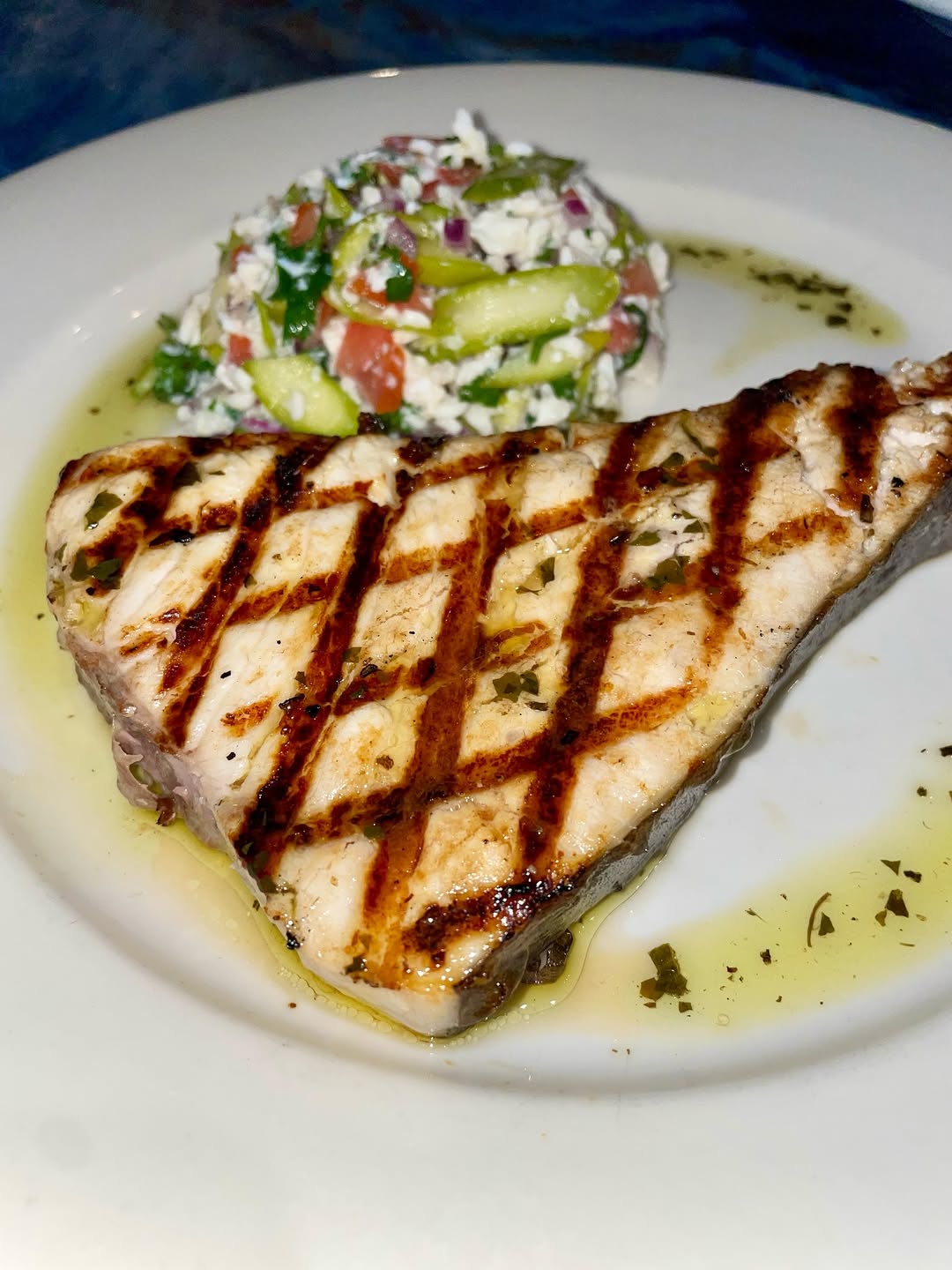Some fish are delicate and fussy. Swordfish is not one of them. It’s the reliable friend who shows up early, brings snacks, and doesn’t complain when you crank the grill too hot.
With its firm, meaty texture, swordfish takes well to bold flavors and high heat – two things home cooks often underestimate in seafood.
Today, we’re keeping it clean, bright, and modern with a fresh ginger-lime marinade that turns a simple grilled swordfish steak into something worthy of your favorite restaurant.
And yes, it cooks in minutes. If only everything else in life worked that way.
Why This Ginger-Lime Grilled Swordfish Works
Swordfish is the steak of the sea. It’s robust enough to handle citrus, ginger, and even a whisper of soy sauce, yet refined enough that you never feel like you’re eating something heavy.
The flavors in this recipe hit that sweet spot: zesty acidity, warm ginger heat, and a touch of umami for balance.
Here’s what makes this recipe shine:
- Cooks fast – Less than 10 minutes on the grill.
- Bright flavor profile – Lime and ginger make everything taste fresh.
- Hard to mess up – Swordfish stays firm and forgiving.
- Minimal ingredients, big payoff – The kind of recipe that makes it look like you tried. (You did, technically.)
I’ve cooked thousands of pounds of seafood over the years – professional kitchens, beachside grills, backyard experiments that may or may not have set off an alarm – and this combo is one that always gets a “Wow, what is this?” response.

Choosing the Best Swordfish at the Market (Without Looking Lost)
Buying swordfish can feel like an audition in front of the seafood counter – everyone suddenly becomes a judge. But here’s the chef rule: fresh swordfish should look like it just woke up from a restful nap, not like it survived a hard week.
Look for steaks that are firm, slightly pink or ivory-toned, and free from dark spots. The smell should be mild – if it reminds you of low tide, politely back away. Ask your fishmonger when it arrived; a good one will tell you proudly.
A great one will warn you if it’s past its prime. And thickness matters, so aim for 1- to 1.5-inch steaks for even grilling.
If you’re buying frozen, no shame – it’s often higher quality than the “fresh” fish that’s traveled more than you did last year. Just thaw overnight in the fridge. Pick smart, and half your cooking work is already done.
Understanding the Science of Swordfish Texture (Nerdy, but Useful)
Swordfish behaves differently from most seafood because its muscle structure is denser – closer to beef than flaky fish. That means you get a firm bite that doesn’t fall apart on the grill, and it also means the fish tolerates high heat without panic.
When you grill salmon, you babysit it. When you grill swordfish, you take a sip of your drink and relax. The key is moisture retention. Swordfish naturally has more connective tissue and a higher fat content than delicate white fish, so it stays juicy longer.
But it’s still possible to overcook it – think rubber sandal vibes. That’s why watching for opacity, firm-but-springy texture, and hitting that 130–135°F sweet spot matters.
Understanding the structure helps you make better decisions, like why we use short marinades, high heat, and minimal flipping. You’re not guessing – you’re cooking with intention.
The Case for Marinating Less (Why 15–30 Minutes Is Enough)
People assume marinating for hours automatically makes food better. Not with citrus-based marinades – especially not with swordfish. Lime juice is acidic, which means it starts breaking down the fish almost immediately.
After 15 minutes, flavor has already penetrated the outer layer. After 30 minutes, you’ve reached peak balance: bright flavor, tender texture, and zero mushiness. Beyond that, the lime begins “cooking” the fish, turning the exterior chalky and soft.
Ginger and garlic are also potent; they don’t need all day to make a statement. Short marinating keeps the flavors clean and modern instead of overpowering or muddy. It also makes this recipe a weeknight hero – you’re not waiting around for some 4-hour ritual.
You get maximum flavor in minimal time, which is exactly how great seafood should work. Chef rule: short marinade, high heat, fast cook = perfect grilled swordfish every time.

Avoiding Common Grilling Mistakes (That Ruin Good Fish)
You can ruin great seafood faster than you can say “Where did I put the tongs?” The biggest offense: starting with a cold grill. Swordfish needs a hot surface to sear quickly and release cleanly – otherwise, it sticks, tears, and cries a little inside.
Another mistake is over-marinating. Citrus isn’t patient. Give swordfish too much lime time, and you’ll end up with mushy edges. Then there’s the flip syndrome – people who flip constantly as if turning the fish enough times will earn them bonus points.
It won’t. Flip once, maybe twice if you’re feeling rebellious. And stop pressing the fish down with a spatula like you’re trying to flatten it into a coaster. That just squeezes out juices you want to keep.
Follow the basics – hot grill, short marinade, minimal touching, and proper resting time – and you’ll avoid 95% of the disasters that happen to perfectly good swordfish.
When to Grill Swordfish vs. When to Pan-Sear Instead
Grilling swordfish gives you char marks, smokiness, and bragging rights. But sometimes the grill is not the hero of the day – rain happens, wind happens, or maybe the grill is buried under last year’s ambition.
That’s when pan-searing steps in. A cast-iron skillet gives swordfish a gorgeous golden crust and a controlled environment that eliminates flare-ups and sticking.
Pan-searing works especially well when you want a more sauce-forward presentation – like spooning over browned butter, a citrus reduction, or a ginger-infused pan sauce. Grilling, on the other hand, is unbeatable when you want smoke, char, and maximum simplicity.
The marinade was practically designed for fire – lime caramelizes, ginger perfumes the air, and the edges crisp beautifully. Both methods produce excellent results; it simply depends on your mood, your weather, and whether you feel like going outside.
Choose boldly. Swordfish can handle it.
Pro Tips From a Chef (Or, Things I Learned the Hard Way)
- Thickness matters. Anything thinner than 1 inch dries out fast.
- Oil the grill grates, not the entire neighborhood. A little goes a long way.
- Fresh ginger > powdered. Powdered ginger tastes like nostalgia, not freshness.
- Flip only once. We’re grilling fish, not playing cards.
- Respect carryover cooking. Swordfish continues to cook after it leaves the grill.
- Use tongs, not a spatula. That firm texture is your friend – treat it confidently.
And yes, if you must hover over the grill like it’s a newborn, go ahead. We’ve all been there.
Variations & Modern Twists
The base recipe is minimalist by design, but if you want to customize it:
- Citrus swap: Lemon or orange instead of lime.
- Add heat: Red pepper flakes, jalapeño, or Thai chili.
- Make it tropical: Add a splash of coconut milk to the marinade.
- Mediterranean vibe: Add oregano, capers, and a touch of yogurt sauce.
- Pan-Grill: Use a cast-iron grill pan if the weather is doing something rude.
- Broiler Method: 5–6 minutes per side, upper rack, watch closely.
Swordfish plays well with others – it’s the Labrador retriever of fish.
Serving Suggestions
You can dress this dish up or down depending on your mood, guests, or how many dishes you’re willing to wash:
- Coconut rice for a tropical balance
- Grilled vegetable – zucchini, peppers, asparagus
- Quinoa or couscous for a light, modern pairing
- Mango salsa (always a crowd-pleaser)
- Arugula salad with a citrusy vinaigrette
Wine pairing? A crisp Sauvignon Blanc, dry rosé, or a clean Chardonnay keeps things bright.

Storage & Reheating
Leftovers:
Up to 2 days in the fridge. Swordfish is sturdy, but not immortal.
Reheat gently:
Skillet, low heat, covered. Just enough to warm through.
Avoid microwaving unless you enjoy your seafood with the texture of the eraser on a No. 2 pencil.
Taming the Mighty Swordfish on the Grill – The Brave Knights of the Ocean
This grilled swordfish with fresh ginger and lime is proof that seafood doesn’t need to be complicated to be spectacular.
When you use bold aromatics, proper technique, and a little heat management, the payoff is big: a dish that’s clean, modern, flavorful, and effortlessly impressive.
Plus, it’s fast. Faster than scrolling to the bottom of a recipe to find out how long you were supposed to marinate something. (Don’t worry – you already passed that test.)
Featured image credit: @artiescityisland

